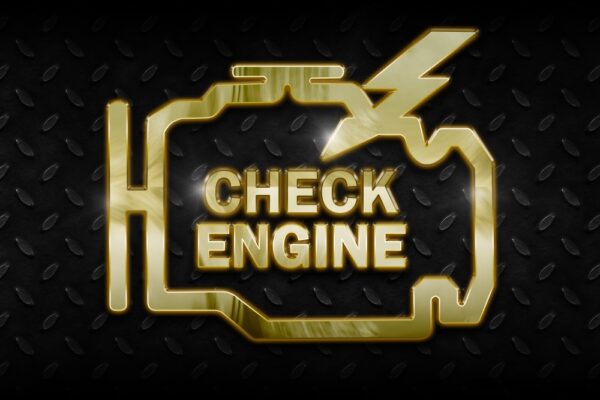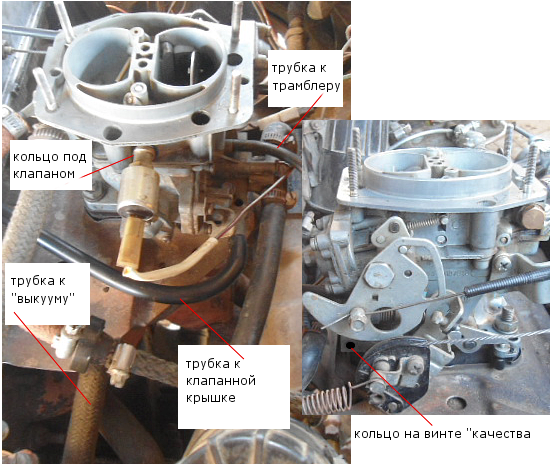
Why does a car with a carburetor stall when you press the gas pedal
Content
In the carburetor, this effect is first realized by emulsion tubes, which produce the primary mixing of fuel and air in certain proportions.
Despite the fact that cars with carburetor engines have long been discontinued, hundreds of thousands, if not millions of such vehicles still drive on the roads of Russia. And every owner of such a vehicle should know what to do if a car with a carburetor stalls when you press the gas.
How does a carburetor work
The operation of this mechanism is based on a process discovered by the Italian physicist Giovanni Venturi and named after him - air passing near the boundary of a liquid drags its particles along with it. In the carburetor, this effect is realized first by emulsion tubes, which produce the primary mixing of fuel and air in certain proportions, and then in the diffuser, where the emulsion is mixed with the passing air stream.
A Venturi tube, namely a diffuser or an emulsion tube, works effectively only at a certain speed of air movement. Therefore, the carburetor is equipped with additional systems that normalize the composition of the air-fuel mixture in various engine operating modes.
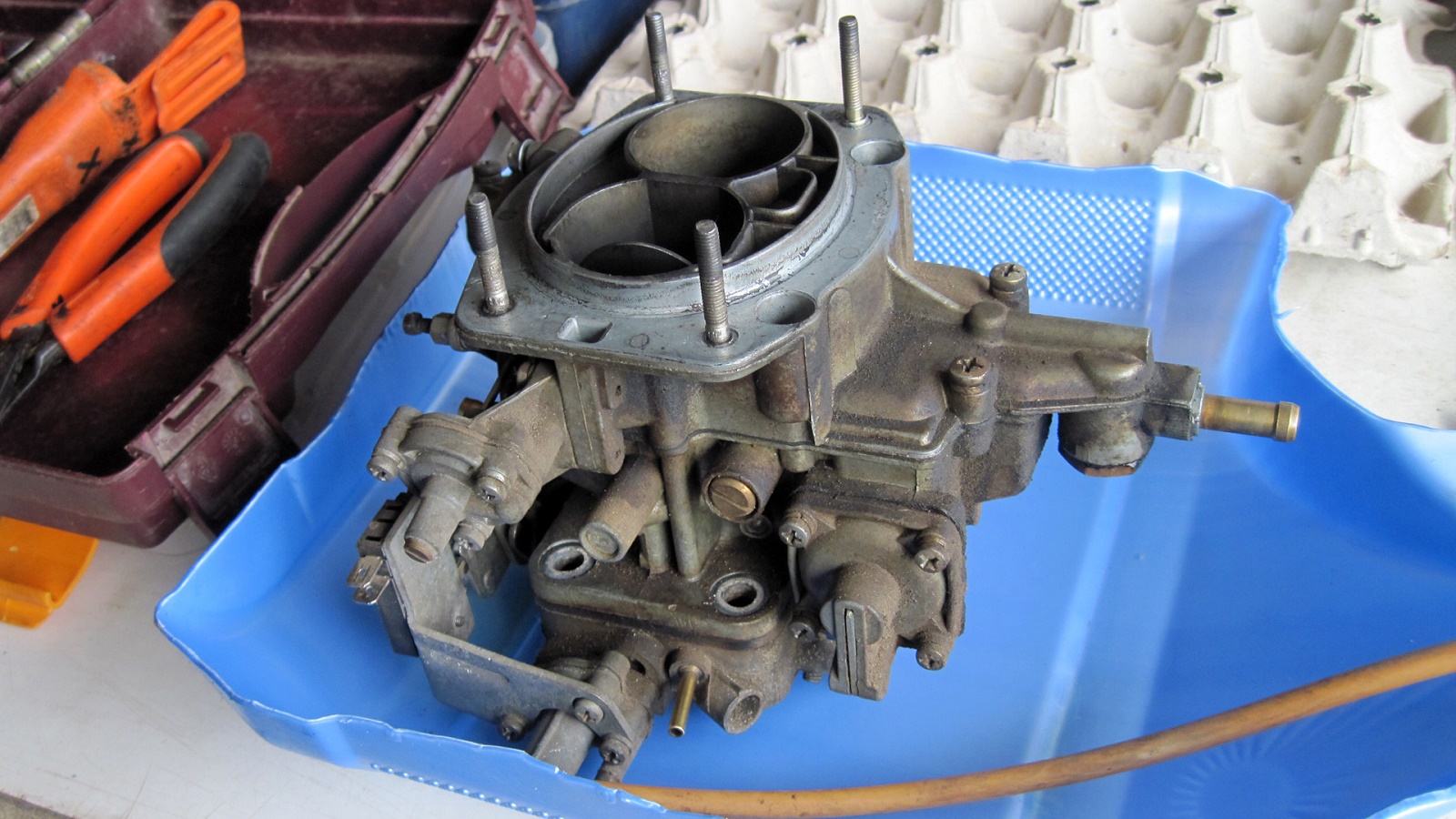
Carburetor device
The carburetor works effectively only when all its parts, as well as the entire engine, are in good condition and tuned. Any malfunction leads to a change in the composition of the air-fuel mixture, which changes the rate of its ignition and combustion, as well as the amount of exhaust gases released as a result of combustion. These gases push the piston and through the connecting rods rotate the crankshaft, which, in turn, converts the energy of their movement into rotational energy and torque.
Why does a carburetor engine stall
The principle of operation of an automobile engine, regardless of the type of fuel and the method of its supply, is the same: entering the cylinders through the intake valves, the air-fuel mixture burns out, releasing exhaust gases. Their volume is so large that the pressure in the cylinder increases, due to which the piston moves towards the crankshaft and turns it. Reaching the bottom dead center (BDC), the piston begins to move up, and the exhaust valves open - the combustion products leave the cylinder. These processes occur in engines of any type, so further we will only talk about the reasons and malfunctions for which the carburetor machine stalls on the go.
Ignition system malfunctions
Cars equipped with a carburetor were equipped with two types of ignition systems:
- contact;
- contactless.
Contact
In the contact system, the voltage surge necessary for the formation of a spark is formed during the break of the contacts attached to the distributor housing and the rotating shaft. The primary winding of the ignition coil is permanently connected to the battery, so when the contact breaks, all the energy stored in it turns into a powerful surge of electromotive force (EMF), which leads to a voltage surge on the secondary winding. Ignition advance angle (UOZ) is set by turning the distributor. Due to this design, the contacts and the mechanical adjustment system of the SPD are the most vulnerable parts.
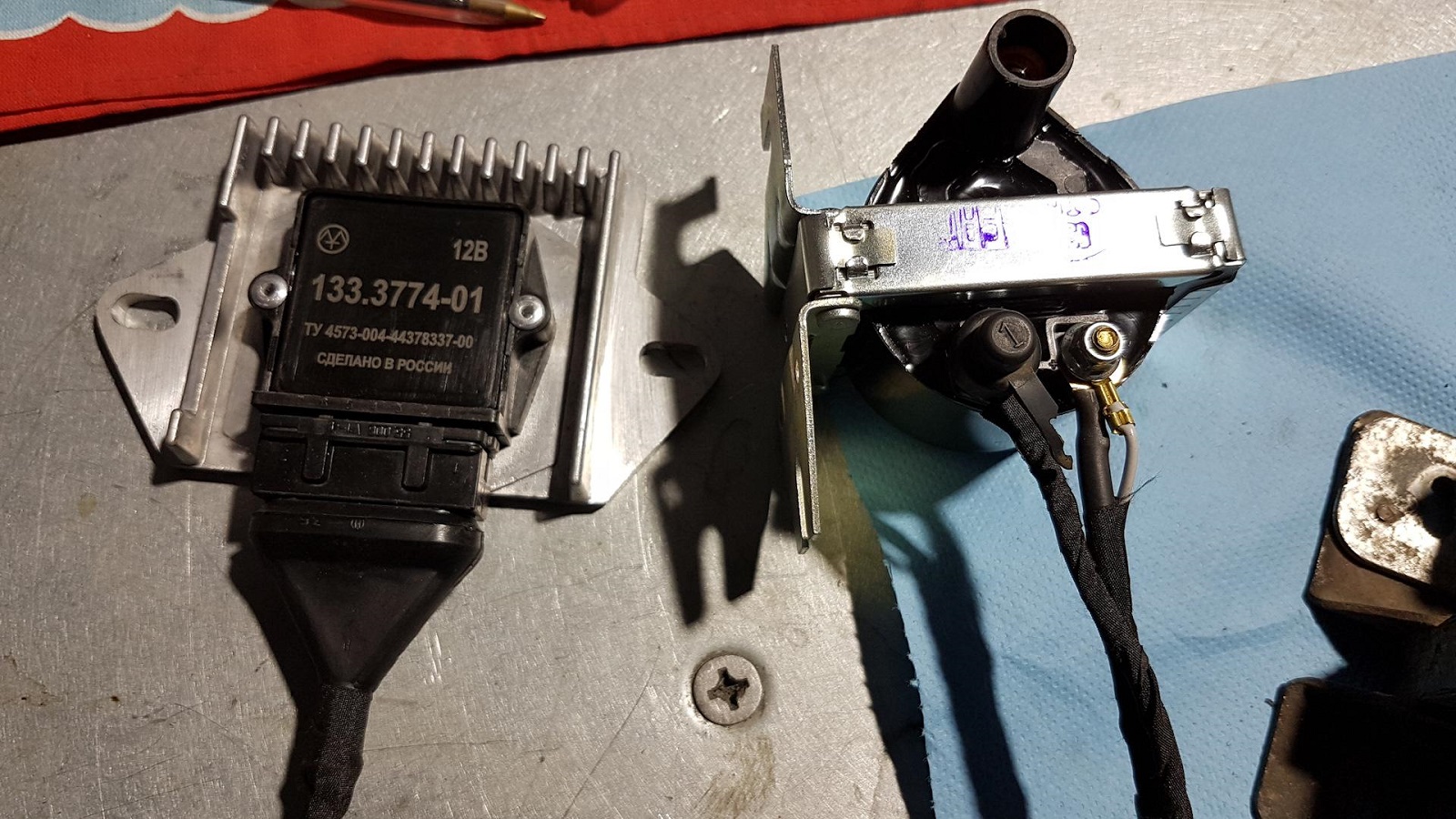
Contact ignition system - inside view
The output of the coil is connected to the cover of the distributor of the distributor, from which it is connected to the slider through a spring and a carbon contact. The slider mounted on the distributor shaft passes by the contacts of each cylinder: during the discharge of the coil, a circuit is formed between it and the spark plug.
Contactless
In a non-contact system, the camshaft of the cylinder head (cylinder head) is connected to the distributor shaft, on which a curtain with slots is installed, the number of which corresponds to the number of cylinders. A Hall sensor (inductor) is installed on the distributor housing. When the engine is running, the camshaft rotates the distributor shaft, due to which the curtain slots pass by the sensor and form low-voltage voltage pulses in it.
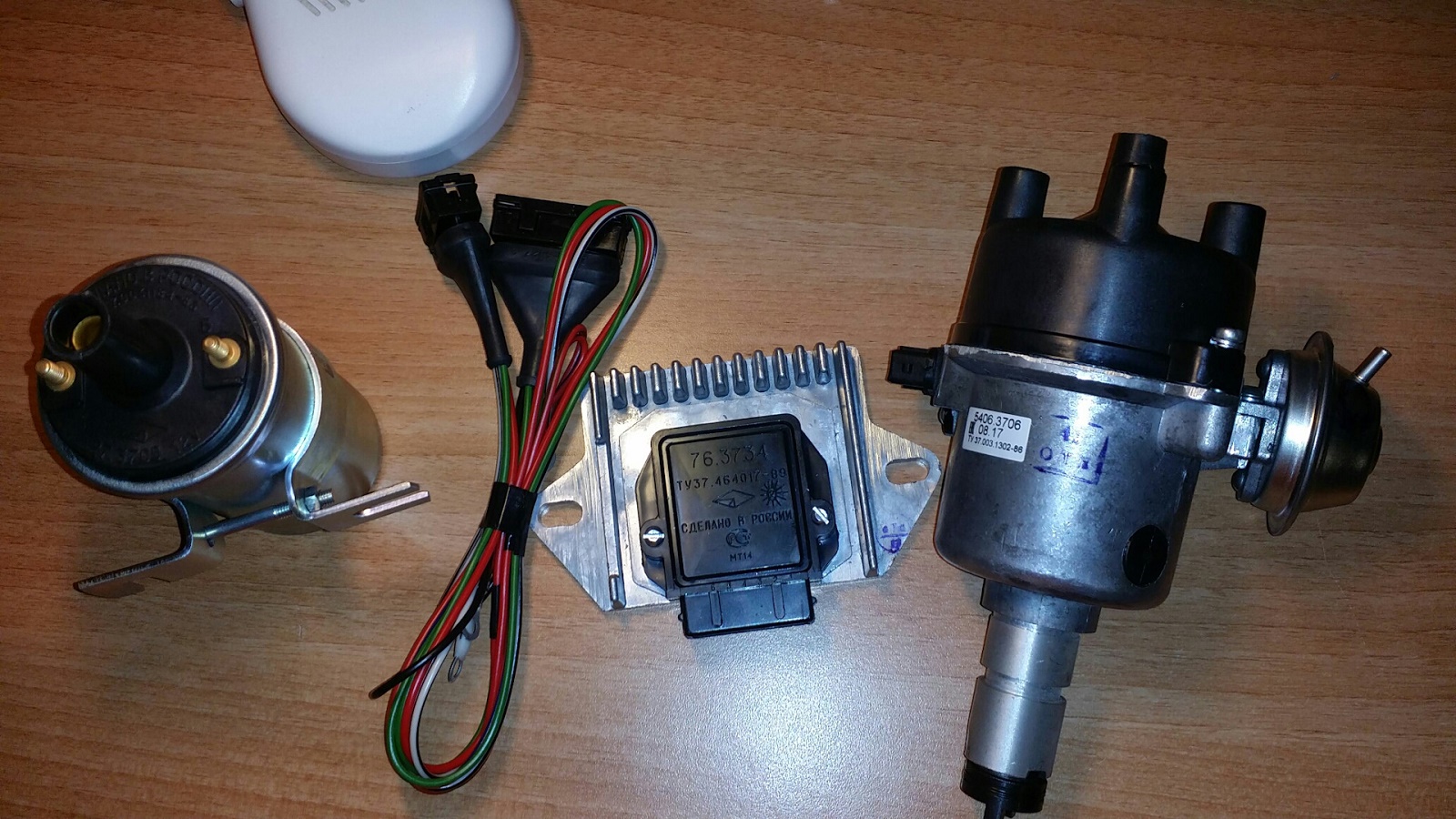
Contactless ignition system disassembled
These pulses are fed to a transistor switch, which gives them enough power to charge the coil and form a spark. A vacuum ignition corrector is installed on the distributor, which shifts the UOZ depending on the operating mode of the power unit. In addition, the initial UOZ is set by turning the distributor relative to the cylinder head. The distribution of high voltage occurs in the same way as on contact ignition systems.
Malfunctions
Here are the main malfunctions of ignition systems:
- wrong UOZ;
- faulty Hall sensor;
- wiring problems;
- burnt contacts;
- poor contact between the distributor cover terminal and the slider;
- faulty slider;
- faulty switch;
- broken or punched armored wires;
- broken or closed coil;
- faulty spark plugs.
These defects are common to any carbureted cars. But cars equipped with an injector are deprived of them due to a different design of the ignition system.
Wrong POD
It is not difficult to check the UOZ on a carburetor machine, for this it is enough to loosen the fixation of the distributor and turn it a little clockwise or counterclockwise. If the parameter is set correctly, then when turning in the direction of increasing the UOZ, the revolutions will first rise, then drop sharply and the stability of the power unit will be disturbed. This is due to the fact that at idle the angle is slightly smaller, so that when the gas is pressed sharply, the vacuum corrector increases the UOZ to the point at which the engine produces maximum speed, which, coupled with the injection of additional fuel, ensures high engine acceleration.
Therefore, when an inexperienced car owner says - I press on the gas and the car stalls on the carburetor, we first of all recommend checking the position of the distributor.
Faulty Hall sensor
A faulty Hall sensor completely blocks the operation of the power unit, and to check, connect an oscilloscope or a voltmeter with a high input resistance to its contacts and ask an assistant to turn on the ignition and turn the starter. If the meter does not show voltage surges, but power is supplied to the sensor, then it is faulty.
Wiring problems
Wiring problems lead to the fact that either the power does not go where it is needed, or the signals generated by one device do not reach the other. To check, measure the supply voltage on all devices of the ignition system, and also check the passage of low-voltage and high-voltage pulses (for the latter, you can use a stroboscope or any other suitable tool).

Checking the voltage on the devices of the ignition system
Faulty vacuum ignition corrector
Any car owner can check its serviceability. To do this, remove the hose going to the carburetor from this part and plug it with your finger. If the corrector is in good condition, then immediately after removing the hose, the idle speed should drop sharply, and the stability of the engine will also be disturbed, and after plugging the hose, XX will stabilize and rise slightly, but will not reach the previous level. Then carry out another test, sharply and strongly press the accelerator pedal. If you press the gas and the car with the carburetor stalls, and after connecting the corrector everything works fine, then this part is working and does not require replacement.
Bad contacts
To identify burnt contacts, remove the distributor cover and inspect them. You can check the operation of the contact ignition using a tester or a light bulb - the rotation of the motor shaft should cause power surges. To check the cover of the distributor, switch the tester to the resistance measurement mode and connect it to the central terminal and the coal, the device should show approximately 10 kOhm.
Faulty slider
On non-contact systems, the slider is equipped with a 5-12 kOhm resistor, check its resistance, replace if necessary. When checking the contacts of the distributor cover, carefully look for the slightest traces of burnout - if there are any, change the part.
Faulty Switch
To check the switch, measure the supply voltage and make sure that it receives signals from the Hall sensor, then measure the signal at the output - the voltage should be equal to the battery voltage (battery), and the current is 7-10 A. If there is no signal or it is not the same, change the switch.
Broken armored wires
If the armored wires are pierced, then a spark will jump between them and any grounded part, and the power and throttle response of the motor will drop dramatically. To test them for a breakdown, connect a screwdriver to the negative terminal of the battery and run it along the wires, a spark will confirm their breakdown. If you think that the wire is broken, connect a stroboscope to it, as close as possible to the candle, if there is no signal, then the diagnosis is confirmed (although there may be a problem with the distributor).
Broken or broken ignition coil
To check the ignition coil, measure the resistance of the windings:
- primary 3–5 ohms for contact and 0,3–0,5 ohms for non-contact;
- secondary for contact 7-10 kOhm, for non-contact 4-6 kOhm.

Measuring the resistance on the ignition coil
The most reliable way to check the candles is to install a new set instead of them, if the engine performance has improved, then the diagnosis is confirmed. After 50-100 km, unscrew the candles, if they are black, white or melted, you need to look for another reason.
Fuel system malfunctions
The fuel supply system includes:
- fuel tank;
- gas pipeline;
- fuel filters;
- fuel pump;
- check valve;
- two-way valve;
- ventilation hoses;
- separator.
All elements are hermetically connected to each other and form a closed system in which fuel constantly circulates, because it enters the carburetor under slight pressure. In addition, many carbureted vehicles have a fuel tank venting system that equalizes the pressure in it when gasoline evaporates due to heating and lowering the fuel level caused by the operation of the engine. The entire fuel supply system is in one of three states:
- works fine;
- works abnormally;
- does not work.

Checking for malfunctions in the fuel supply system
If everything works properly, then the carburetor receives enough fuel, so its float chamber is always full. If the system does not work, then the first sign is an empty float chamber, as well as the absence of gasoline at the carburetor inlet.
Checking the fuel supply system
To check the operation of the system, remove the supply hose from the carburetor and insert it into a plastic bottle, then turn the engine with a starter and pump fuel manually. If gasoline does not flow from the hose, then the system is not working.
In this case, proceed as follows:
- check if there is gasoline in the tank, this can be done either using the indicator on the front panel or by looking into the tank through the fuel intake hole;
- if there is gasoline, then remove the supply hose from the fuel pump and try to suck out gasoline through it, if it works, then the pump is faulty, if not, then the defect is either in the fuel intake, or the fuel line, or a clogged coarse fuel filter.
The sequence of checking the fuel supply system is advised to be carried out according to the following scheme: gas tank-pump-fuel line.
If the system works, but incorrectly, because of which the car starts and stalls, it doesn’t matter if it’s a Niva or some other, for example, a foreign car, but the carburetor has been checked and is working, then do this:
- Open the gas tank and collect fuel from the very bottom and pour it into a bottle. If after a day the contents stratify into water and gasoline, then drain everything from the tank and carburetor, then fill in normal fuel.
- Examine the bottom of the tank. A thick layer of dirt and rust indicates that it is necessary to flush the entire fuel system and carburetor.
- If there is normal gasoline in the tank, then check the condition of the fuel line, it may be damaged. To do this, roll the car into the pit and carefully inspect the bottom from the outside, because that is where the metal pipe goes. Inspect the entire tube, if it is flattened somewhere, replace it.
- Disconnect the return hose from the carburetor and blow strongly into it, the air should flow with little resistance. Then try to suck air or gasoline out of there. If air cannot be blown into the hose, or something can be sucked out of it, then the check valve is faulty and needs to be replaced.
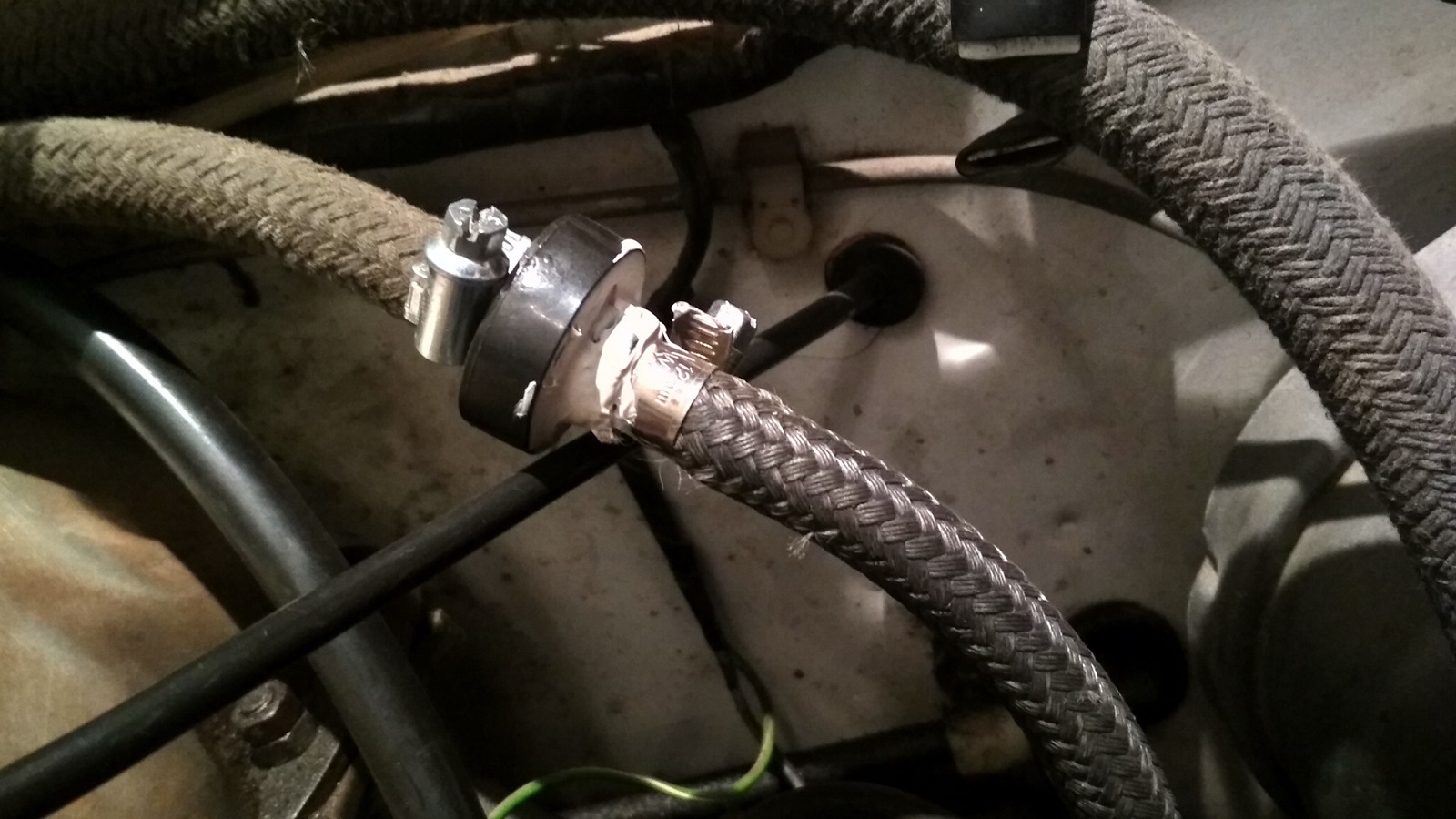
Disconnecting the return hose from the carburetor
If fuel comes to the pump, but does not go further either in manual pumping mode or when the engine is running, then the problem is in this part. Replace the pump, then check how the manual pump works - after each press, gasoline should come out of this device in small portions (a few ml), but under good pressure (stream length of at least five cm). Then turn the engine with a starter - if fuel does not flow, the rod connecting the camshaft and the pump is worn out. In this case, replace the stem or grind off the gasket by 1–2 mm.
Air leaks
This error may occur in the following places:
- under the carburetor (breakdown of the gasket between it and the intake manifold;
- on any part of the brake booster vacuum system, which includes a vacuum booster (VUT) and a hose connecting it to the intake manifold;
- on any part of the UOZ adjustment system.
The main symptom is a decrease in power and unstable idling (XX). Moreover, XX are aligned if the suction cable is pulled out, thereby reducing the air supply. To find a defective area, start the engine with the suction extended as far as possible, then open the hood and look for the source of the hiss by ear.
If such a search does not help to detect a problem, then remove the hose from the VUT and monitor the operation of the engine. A strong increase in instability, shaking and tripping indicate that the leak is somewhere else, and a slight deterioration will confirm the leak in the VUT system. After making sure that there is no air leakage in the VUT area, remove the hose from the vacuum ignition corrector - a slight deterioration in engine operation will confirm the problem of this system, and a strong one indicates a breakdown of the gasket under the carburetor or its weak tightening.
Carburetor malfunctions
Here are the most common carburetor malfunctions:
- incorrect fuel level in the float chamber;
- dirty jets;
- the solenoid valve of the forced idle economizer (EPKhK) does not work;
- the accelerator pump does not work;
- The power saver does not work.
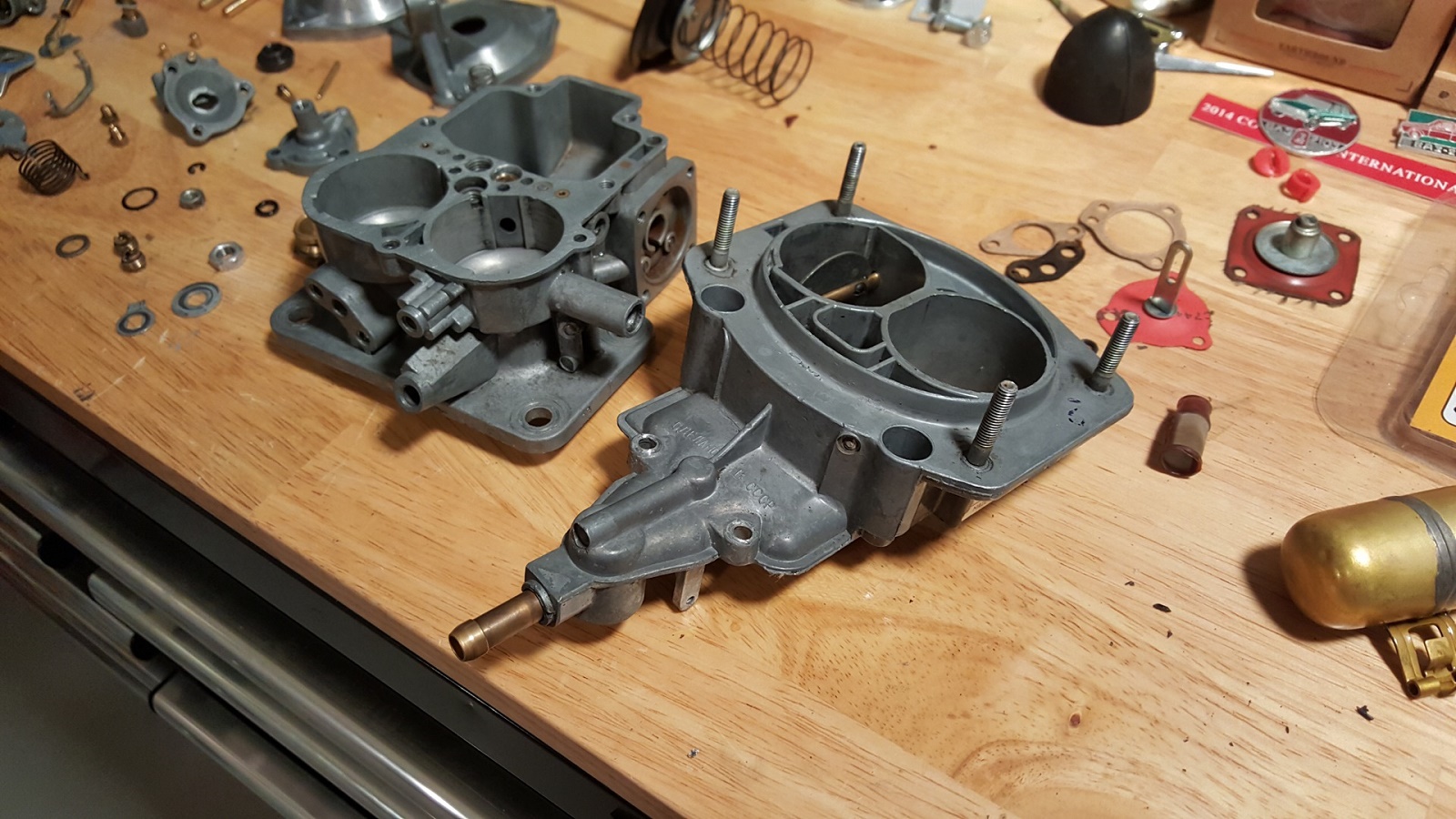
Bulkhead carburetor - finding out the causes of the malfunction
Incorrect fuel level in the float chamber
This leads to the fact that the carburetor can both pour fuel, that is, make a highly enriched mixture, or not top up, forming an excessively lean mixture. Both options disrupt the operation of the motor, up to its stop or damage.
Dirty jets
Dirty jets also enrich or lean the mixture, depending on whether they are installed in the gas or air passage. The cause of fuel jet contamination is gasoline with a high tar content, as well as rust accumulating in the fuel tank.
EPHH valve does not work
EPHH reduces fuel consumption when descending a hill in gear, if it does not shut off the fuel supply, then a carburetor car with a 3E engine or any other stalls due to glowing ignition of hot candles. If the valve does not open, then the car turns out to start and idle only when the gas pedal is pressed at least a little or the idle speed is added to the carburetor.
The accelerator pump delivers additional fuel when the gas pedal is pressed sharply, so that the increased air intake does not over-deplete the mixture. If it does not work, then when you press the gas pedal, the car with the carburetor stalls due to a severe lack of fuel in the mixture.
Faulty accelerator pump
Another reason why a car with a carburetor stalls when you press the gas is a faulty accelerator pump. When the driver presses the gas, a serviceable carburetor injects additional fuel into the cylinders, enriching the mixture, and the corrector shifts the UOZ, due to which the engine picks up speed sharply. Checking the accelerator pump is easy. To do this, remove the air filter housing and, looking into the large carburetor diffusers (holes through which the main air flow passes), ask the assistant to press the gas strongly and sharply several times.
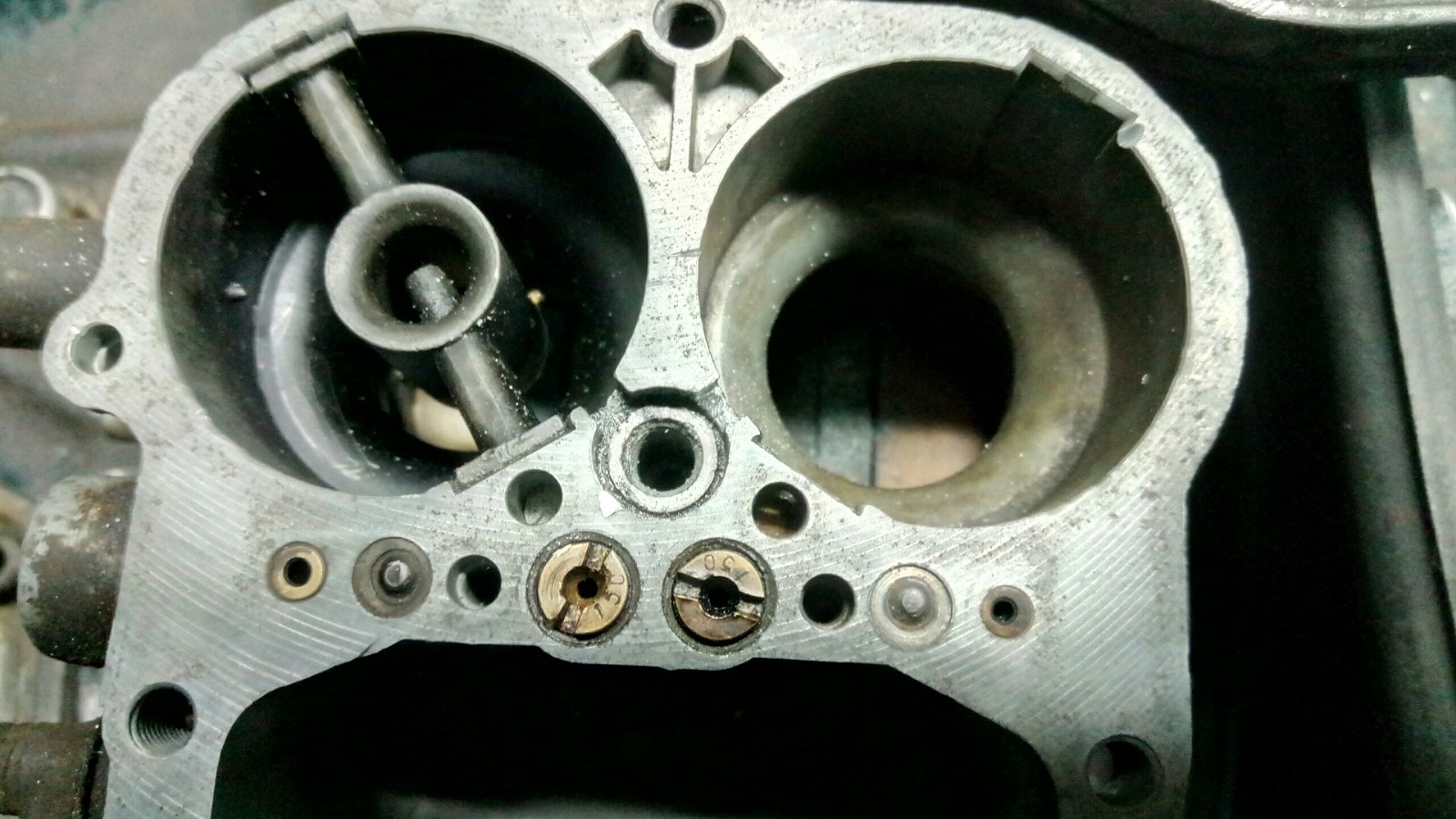
View Carburetor Diffusers
If the accelerator pump is working, then you will see a thin stream of fuel that will be injected into one or both holes, and you will also hear a characteristic squirting sound. The lack of injection of additional fuel indicates a malfunction of the pump, and partial disassembly of the carburetor will be required to repair it. If you do not know how to do this work on your car, then contact any minder or carburetor.
Power saver not working
The power mode economizer increases the fuel supply when the gas pedal is fully depressed and the maximum load on the power unit. If it does not work, then the maximum power of the motor drops. This malfunction does not appear during a quiet ride. However, at high speeds, when the engine is running at speeds close to maximum, and the gas pedal is fully depressed, the incorrect operation of this system greatly reduces the power of the power unit. In particularly unfortunate cases, the engine may overheat or stop.
How to determine the cause of poor engine performance
Without understanding the principles of operation of the engine and its systems, it is impossible to determine why the power unit suddenly began to fail or stall, however, even an understanding of the principles of its operation is useless without the ability to correctly interpret the external manifestations and test results. Therefore, we have compiled an overview of the most common malfunctions of carburetor motors leading to a cessation of operation, as well as their possible causes, and made recommendations for the correct diagnosis.
Remember, all this applies only to carburetor engines, therefore it does not apply to injection (including mono-injection) or diesel power units.
In this section, we will tell you how to look for the cause of a malfunction in case of various problems that arise during the operation of a carbureted car. In the vast majority of cases, the cause of the defect is a malfunction or incorrect setting of the carburetor, however, the technical condition of other systems may affect.
Hard to start and stall when cold
If it is difficult to start a cold engine or the engine stalls when cold, but after warming up, the XX stabilizes and there is no decrease in power or deterioration in throttle response, and fuel consumption has not increased, then here are the possible reasons:
- air leaks;
- the jet of the XX system is clogged;
- EPHX valve jet is clogged;
- the channels of the XX carburetor system are clogged;
- The fuel level in the float chamber is incorrectly set.

Solving the problem of poor cold start
More information about these faults and how to fix them can be found here (Car stalls when cold).
Starts badly and stalls when hot
If a cold engine starts easily, but after warming up, as drivers say, “hot”, it loses power or stalls, and also starts poorly, then here are the possible reasons:
- incorrect fuel level in the float chamber;
- air leaks;
- incorrect adjustment of the composition of the mixture with quality and quantity screws;
- boiling of fuel in the carburetor;
- contact that disappears due to thermal expansion.
If the engine does not lose power, but after warming up it is unstable at idle, then the XX carburetor system is most likely faulty, because the warm-up is performed in the suction mode, and it provides for opening the throttle valve and air movement bypassing the XX system. You will find more detailed information on the causes of such a malfunction and methods of repair here (Stalls hot).
Unstable XX in all modes
If the car stalls at idle, but the engine has not lost power and throttle response, and fuel consumption has remained at the same level, then the carburetor is almost always to blame, or rather its technical condition. And almost always it is either dirt in the XX system, or incorrect adjustment of this parameter. If, in addition to poor idling, the machine loses power or some other defects appear, then a complete diagnosis of the power unit and fuel system is necessary. Read more about all this here (The car stalls at idle).

Engine idle
Stalls when you press the gas
If the car stalls when you press the gas, no matter what type of carburetor it has, Solex, Ozone or some other, a simple check is indispensable. Here is a list of possible reasons:
- wrong UOZ;
- faulty vacuum ignition corrector;
- air leaks;
- faulty accelerator pump.
More information can be found here (Stalls on the go).
Stalls when releasing the gas pedal or braking the engine
If a car, for example, a Niva carburetor, stalls on the go when the gas pedal is released, then the reasons for this behavior are related to a malfunction of the idling system, including the EPHH, which interrupts the fuel supply when the engine is braked. With a sharp discharge of gas, the carburetor gradually goes into idle mode, so any problem in the idling system leads to an insufficient supply of fuel to the power unit.
If the car brakes with the engine, that is, it moves downhill in gear, but the gas is completely released, then the EPHH blocks the fuel supply, but immediately after pressing the accelerator, the economizer should resume the flow of gasoline. The freezing of the valve, as well as the contamination of its jet, lead to the fact that after pressing on the gas, the engine does not start immediately, or does not turn on at all, if this occurs on a winding mountain road, then there is a high probability of an emergency.

stuck valve in the engine
For an inexperienced driver, this situation often looks like this - you press the gas and the car with the carburetor stalls, there is no expected jerk or smooth acceleration (depending on many parameters), which makes the person behind the wheel get lost and may make a mistake.
We recommend that you trust professionals to clean the XX carburetor system, because any mistake can aggravate the situation even more.
Conclusion
If, when you press the gas, a car with a carburetor stalls, then the technical condition of the car leaves much to be desired: we recommend immediately diagnosing the engine and its fuel system. Do not delay with diagnostics if other problems occur, one way or another related to a carburetor malfunction, otherwise the vehicle may stall in the most unfortunate place.

